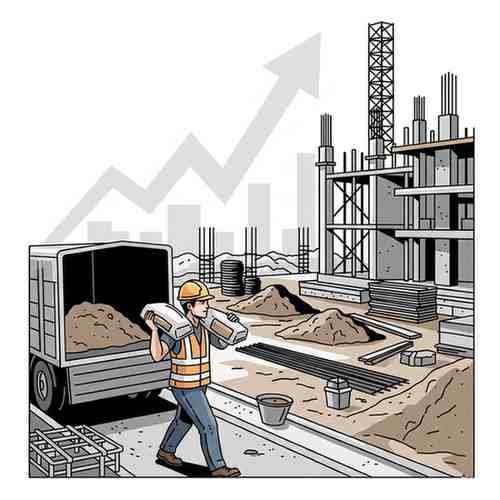
The RBI’s Rate Cycle and Its Ripple Effect on Cement Sector Capex & Valuations
The RBI’s Rate Cycle and Its Ripple Effect on Cement Sector Capex & Valuations
The Indian cement sector is a fundamental barometer of the nation’s economic health. As a core component of construction and infrastructure development, its performance is intrinsically linked to the country’s growth trajectory. While investors typically focus on operational metrics like production volumes, pricing power, and input costs, a powerful macroeconomic force often dictates the sector’s long-term prospects: the Reserve Bank of India’s (RBI) monetary policy.
Thank you for reading this post, don't forget to subscribe!The RBI’s interest rate cycle creates a significant ripple effect that cascades through the cement industry, influencing everything from large-scale capital expenditure (capex) decisions to the ultimate valuation of listed cement companies. Understanding this impact of monetary policy on cyclical stocks is crucial for any comprehensive cement stock valuation analysis.
The Transmission Mechanism: From Repo Rate to Real Estate
The RBI’s primary tool for conducting monetary policy is the repo rate—the rate at which it lends to commercial banks. By adjusting this rate, the RBI influences the overall cost of money in the economy to manage inflation and stimulate growth. The RBI interest rate impact on the cement sector is transmitted through two primary channels:
- The Cost of Capital Channel: The cement industry is exceptionally capital-intensive. Building new integrated plants, setting up grinding units, and investing in waste heat recovery systems require substantial funding. When the RBI raises interest rates, commercial banks pass on these higher costs, making borrowing more expensive for corporations. This directly affects the financial viability of new projects.
- The Demand Channel: The cement sector’s fortunes are inextricably tied to the health of the real estate and infrastructure sectors. Higher interest rates cool down the economy by making home loans, car loans, and corporate loans more expensive. This leads to reduced housing demand, deferred real estate projects, and a slowdown in private infrastructure spending, thereby curbing the demand for cement. This explains how interest rates affect infrastructure stocks and their suppliers.
The Capex Conundrum: Growth vs. Prudence
One of the most direct consequences of the RBI’s rate cycle is its influence on cement sector capex trends in India.
During a monetary easing cycle (when the RBI is cutting rates), the environment becomes highly conducive to expansion. Lower borrowing costs improve project IRR (Internal Rate of Return), and the general economic optimism fuels expectations of robust future demand. Cement companies, anticipating a construction boom, are incentivized to undertake aggressive capex to add new capacity and secure a larger market share. This period often sees a flurry of announcements for new plants and expansion projects.
Conversely, a monetary tightening cycle (when the RBI is hiking rates) instills a sense of caution. The “double whammy” of higher financing costs and the prospect of weakening demand makes management teams risk-averse. Large-scale, debt-funded capex plans are often deferred or shelved entirely. The focus shifts from expansion to consolidation, cost optimization, and balance sheet strengthening. Investors can track these trends through company announcements, investor presentations, and credit rating reports.
The Valuation Ripple Effect
The shifts in capex and demand ultimately flow down to impact the stock market valuations of cement companies. This ripple effect can be understood through three lenses:
- Earnings Impact: In a high-interest-rate environment, the combination of higher interest expenses (on existing and new debt) and lower sales volumes due to subdued demand puts direct pressure on a company’s profitability. Lower earnings per share (EPS) naturally lead to downward pressure on stock prices.
- Discounted Cash Flow (DCF) Impact: For analysts performing a rigorous cement stock valuation analysis, the discount rate is a critical input in their DCF models. This rate, which is used to calculate the present value of a company’s future cash flows, is heavily influenced by the prevailing risk-free interest rate. When the RBI raises rates, the discount rate used by analysts increases. A higher discount rate results in a lower present value of future cash flows, thereby reducing the calculated intrinsic value of the stock, even if the company’s long-term growth story remains intact.
- Investor Sentiment: The stock market is heavily influenced by sentiment. During a rate-hiking cycle, sentiment towards cyclical sectors like cement turns bearish. Investors tend to rotate their capital towards defensive sectors (like FMCG or Pharmaceuticals) that are less affected by economic downturns. This shift in capital allocation can cause cement stocks to underperform the broader market, regardless of their individual operational performance. The reverse is true during a rate-cutting cycle, when optimism about an economic recovery draws investors back to cyclical stocks.
Conclusion: A Macro Lens for Micro Analysis
The intricate dance between the RBI’s monetary policy and the cement sector highlights the necessity of a top-down investment approach. While a bottom-up analysis of a company’s operational efficiency, brand strength, and market share is essential, it is incomplete without considering the overarching macroeconomic environment.
The RBI’s rate decisions act as a powerful signal for the future direction of the economy and, by extension, the cement industry. By understanding how changes in the repo rate influence borrowing costs, demand dynamics, capex cycles, and investor sentiment, market participants can make more informed decisions. For those looking to invest in the cement sector, tracking the RBI’s commentary on inflation and growth is just as important as analyzing a company’s quarterly earnings report. It provides the crucial context needed to navigate the inherent cyclicality of this foundational industry.
Related Blogs:
Understanding the Interplay of Construction, Infrastructure, and Related Sectors for Portfolio Growth
Top 5 Construction Stocks in India
How Construction & Infrastructure Stocks Can Enhance Your Portfolio’s Diversification
Top 5 Infrastructure Stocks to Buy in India in 2025
Beyond Construction: Exploring the Ripple Effect of Infrastructure Development on Related Sectors
The Infrastructure Ecosystem: Exploring Investment Opportunities in Allied Sectors alongside Construction
Top 5 Cement Stocks in India
Best Infrastructure Stocks in India
Best Cement Stocks in India
Top 5 Steel Stocks in India: A Guide for Investors in 2025
Top Stock Picks for 2025 Best Investment Opportunities
Top 5 Real Estate Stocks in India

